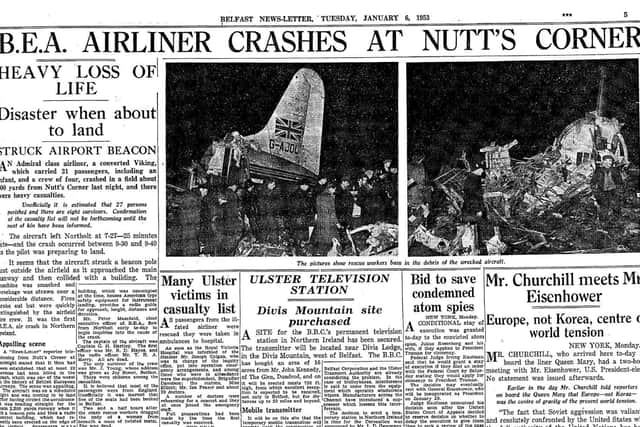Shock as Nutt’s Corner air disaster kills dozens (1953)
and live on Freeview channel 276
When he returned to London Mr Masefield said that the aircraft had been making a very low approach and hit a post supporting one of the approach lights a quarter of a mile from the runway.
“It touched down in a the runway,” he said, “and, the runway and, as bad luck would have it, went smack into a very substantial brick and concrete building right on the line of approach 200 yards from the end of the runway.
Advertisement
Hide AdAdvertisement
Hide Ad“The building disintegrated with the aeroplane and all the casualties were caused by the break up, which burst the plane wide open.


Mr. Masefield said of the Nutt's Corner rescue services: “They worked extremely well and did a magnificent job. They were on the spot very quickly.”
He said that visibility at the time of the crash was very good. The aircraft was landing on the ground control approach radar system.
The report of the investigation officers of the Ministry of Civil Aviation was to go to the Minister, Mr A T Lennox-Boyd, who will decide whether or not a public inquiry was to be held.
Advertisement
Hide AdAdvertisement
Hide AdSeven of the eight people injured in the crash are in the Massereene Hospital, Antrim. Two of them, Mr Paul Scarlett and Mr J Brower are seriously ill. The others injured were described as “fairly comfortable”.
The News Letter reported: “Throughout Monday night with the aid of searchlights, rescue workers toiled among the wreckage. Personal possessions of the dead and the injured, scattered among the debris, were recovered and piled neatly in pathetic heaps beside the aircraft.
“Wreckage was scattered over an area of about 150 yards. One engine was flung 40 yards, a propeller was hurled into an adjoining field.
“Yesterday all that remained intact was the tail plane, standing gauntly above the charred and blackened wreckage.
Advertisement
Hide AdAdvertisement
Hide Ad“The aeroplane had carried a lead container of radioactive seeds for the new radiotherapy centre at Purdysburn Hospital, Belfast. All night a search was made for this consignment, and it was discovered intact yesterday morning. The material sought, and now delivered to the radiotherapy centre, was 32 kilos of radon, a gas given off by radium.”
When a News Letter reporter visited Nutt's Corner yesterday they were informed by Mr R L Carter, BEA area manager, that the accident was the first there since the corporation began its service from the airport.